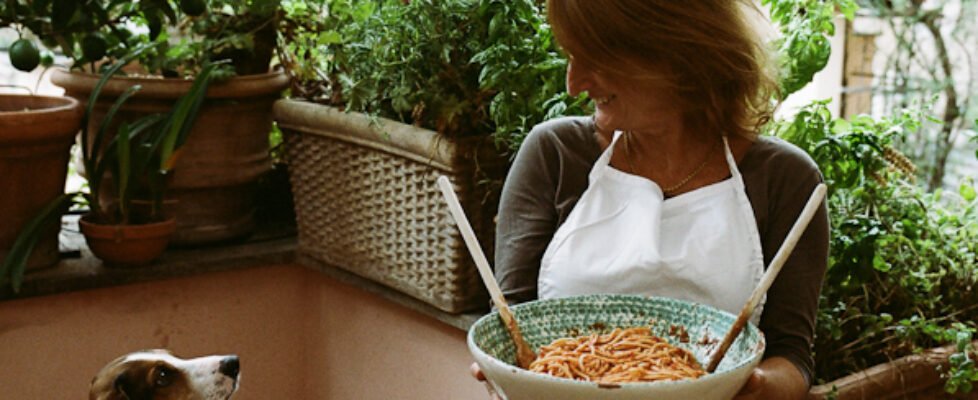Campo de’ Fiori Market in Rome
Campo de’ Fiori is a market in Rome that a lot of people love. It is also a market that a lot of people love to hate. The open air market in Campo de’ Fiori is undeniably one of Rome’s most famous. Much of this has to do with its location. It is pretty much the only open air market left in the center of Rome. Each of Rome’s rione, or neighborhoods, used to have an open air market. And when I first moved back to Rome in early ‘90s, I’d do much of my shopping in markets that were steps away from the Trevi Fountain, the Spanish Steps and the Viminale.
Sadly, things change. Due to transformed shopping habits, rising real estate prices and shifting family customs most of these markets have died a slow death over the last two decades.
One of the reasons is the explosion of lower priced supermarkets that descended on the city. They are obviously cheaper, and often more convenient. Another reason are changing shopping habits. Wives and nonne no longer shop daily for the main meal prepared for husbands and sons who come home from work for lunch. Most women work these days, and so families tend to do their shopping on weekends, at the less expensive supermarkets. And finally, rising real estate prices and taxes have made selling apples and oranges from a cart not so much of a career calling.
Like the other markets in Rome, Campo de’ Fiori was dying its own slow death. By the early ‘90s the market was a far cry from the one I remembered from the time I lived here as a child in the ’70’s. The modern version was not the crowded, chaotic and colorful mashup of fruits, vegetables, meats, fish, cheeses and flowers that I loved. When I moved back to Rome in 1990, instead of massive piles of artichokes and melons there were stretches of empty cobblestoned paving where stands used to crowd each other out. Each year, as I pushed my daughter’s stroller around the square, there would be fewer and fewer stands, and more and more empty space. The meat vendors were the first to go, then the fish vendors, until finally there were just a handful of produce stands holding guard.
Until, finally, the tide began to turn. One day I showed up and the small spice stand at one end of the piazza had expanded to take over four spaces. Not only selling spices, he was now offering olives, dried fruit and nuts and bags of sun dried tomatoes and porcini.
Other new arrivals targeted what turned out to be the biggest groups of visitors to the market these days: tourists. Stands selling T shirts, sun hats and souvenirs began to fill up other spaces.
At the same time the established fruit and vegetable stands, who offer some of the best (and most expensive) produce in the city began to get into the game. Not content with merely selling high end produce to the wealthy residents of Rome’s centro storico, they also began to turn some of their fruit into fruit salad or fresh juices, which were grabbed up by tourists. Similarly the housewares stand started selling brightly colored ceramics and cute pasta cutters next to the more practical forks and can openers.
The most recent additions to the market are stands that appear to be selling ‘food’ but are really selling ‘food like’ souvenirs. Yes, I’m talking about bags of multi-colored, anatomically-shaped pasta and pink limoncello in violin shaped bottles (what is that stuff anyway?)
I admit it would be easy to dismiss the market these days as a purely Disney-like tourist attraction. Yes, there are some stands that are there only to make a profit by selling strange ‘food-like’ products and souvenirs to tourists. But the 7 or 8 stands that still sell produce are among the best in Rome. During a recent visit I saw plump strawberries from Terracina; beautiful flower-bedecked zucchine romane; pencil-thin wild asparagus; and what were probably some of the only wild ovoli mushrooms on sale in Rome that day. All being sold by the same families who have been standing behind their fruits and vegetables for generations.
No, its not a farmer’s market, and no, it’s not necessarily local and almost never organic. But in the age when open markets are a dying breed, I’m just happy that there is still a market there. And if some of the icky stuff for sale can help subsidize the truly excellent produce side of things, then I think that is a good thing. Sadly, not all markets can be farmers markets.
There has been an open air market in Campo de Fiori for hundreds of years. And I’m pretty sure that centuries ago, there were stands that were selling schlock too. Things change, for better and for worse. And at the end of the day, if the changes that have gone on and continue to go on in Campo de Fiori mean that the market still exists, then I’m all for change. In my book a changed market is better than no market at all.
-Elizabeth MInchilli

Elizabeth Minchilli is the author of Eating Rome: Living the Good Life in the Eternal City. She can be found on her blog, Elizabeth Minchilli in Rome, where are links to her best seiling apps to Eating your way around Italy.
